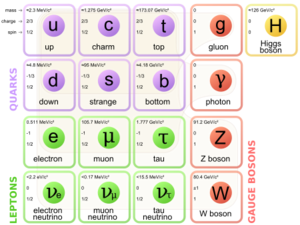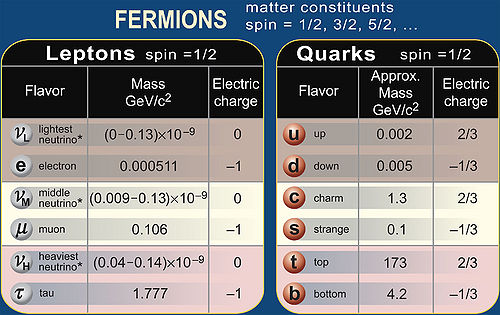Elementary Particles and Particle Physics Theory
Vishesh Ramesh on elementary particles and particle theory
Short Description of Topic
History
Particle physics, and subatomic physics, has had a long history with many different and diverse scientists playing a part. The idea that matter is composed of elementary particles can be traced as far back as the 6th century B.C.E, and to scientists and philosophers of ancient Greece, India, the Middle East, and Western Europe. These early hypotheses rose from philosophical speculation and reasoning as opposed to experimentation.
John Dalton in the 19th century provided his theory of the atom, which was then believed to be the utmost fundamental particle. By the end of the 19th century, however, it was discovered that atoms were composed of yet smaller particles, when the electron and its charge was discovered via experimentation. Ernest Rutherford’s gold scattering experiment confirmed the existence of the nucleus and the proton, and further experimentation in the early 20th century led to the confirmation of the existence of the neutron.
By the middle of the 20th century, even smaller particles composing atomic nuclei were hypothesized, as the nuclear strong force was also discovered and established as a fundamental force alongside gravity and electromagnetism. Around this time, the understanding of fundamental particles also deepened, particularly with Erwin Schrödinger’s work in quantum physics and the establishment of wave-particle duality of the photon and Einstein’s work on the photoelectric effect showing photons to carry electromagnetic force.
In the mid-20th century, Marcus Fierz and Wolfgang Pauli formulated and refined the spin-statistics theorem, establishing bosons and fermions. In the time period between 1935 and 2000, positrons, muons, mesons, leptons, baryons, bosons, and neutrinos were discovered at a breathtaking and chaotic pace. The Standard Model is a theory that has its origins in this time period, born of a desire to unite these new subatomic fundamental particles and the four fundamental forces, and in the process of creating it, several more particles were hypothesized and most later discovered. The current formulation of the Standard Model was finalized in the 1970’s.
Elementary Particles
Elementary particles can first be grouped into fermions, particles with mass composing matter and antimatter, and gauge bosons, force carrier particles with no mass. In addition to these two groups, there lies the Higgs Boson in a category of its own, classified as a as a scalar boson.
Fermions: Particles of Matter and Antimatter
Fermions are all fundamental particles that compose matter or antimatter, and therefore have mass. All matter is composed of quarks and leptons, which share a spin of +1/2 in common. Antimatter is composed purely of antiquarks and antileptons.
Matter
Quarks
There are six types of quarks: Up, Down, Charm, Strange, Top, Bottom. All six quarks have a spin of +1/2. Up, charm, and top quarks have a charge of +2/3, while down, strange, and bottom quarks have a charge of -1/3.
Leptons
Leptons are particles with spins of 1/2. Leptons can be broken down into two major classes: charged leptons and neutral leptons. The electron, muon, and tau are the charged electrons, all with a charge of -1. Each of these have a respective neutral lepton, which are termed neutrinos. The speed at which neutrinos travel is hotly contested because it's extremely important and extremely difficult to measure. Many scientists believe neutrinos travel at the speed of light, which would pose a challenge to the idea that only massless particles can travel at the maximum speed of the universe which is the speed of light.
Antimatter
As matter is composed of quarks and leptons, antimatter is composed of antiquarks and antileptons. The antiparticle counterparts of quarks and leptons are mostly identical in property magnitudes but opposite in sign.
Antiquarks
For the six flavors of quarks, there exist antiquarks. Antiquarks have the same magnitude in properties as their quark counterparts, but flipped signs. The charges of each antiquark is the negative of its counterpart's charge.
Antileptons
For every charged lepton flavor there is a corresponding antilepton flavor, so there exist the anti electron, commonly known as the positron, the antimuon, and the antitau. There is still uncertainty however as to whether or not neutrinos have antiparticles. The electron antineutrino, muon antineutrino, and tau antineutrino, are all theorized, but some particle physicists argue that neutrinos may be their own antiparticles. There is yet much research to be done on neutrinos to further understand them.
Gauge Bosons: Massless Carriers of Fundamental Forces
Photon: Carrier of Electromagentic Force
The photon is the guage boson responsible for mediating the electromagentic force. Electromagnetism and the photon are the most well understood force and respective carrier. The photon's mediation of the electromagnetic force can best be explained by the photoelectric effect.
Gluons: Carrier of Strong Force
Gluons mediate the strong force, which is the force between quarks. The attraction between quarks, strong force, is what allows quarks to come together to form hadrons, which can be classified into baryons(combinations of three quarks) and mesons(combinations of a quark and an antiquark). The most well-known baryons are protons and neutrons which form the atomic nucleus. Gluons and the strong force are reponsible for both the attraction between neutrons and protons, and the attraction between quarks that allow neutrons and protons to form. There are altogether eight variations of the gluon.
W and Z Bosons: Carrier of Weak Force
Graviton: (Hypothesized) Carrier of Gravitational Force
Scalar Bosons: The Higgs Boson
Examples
Be sure to show all steps in your solution and include diagrams whenever possible
Simple
Middling
Difficult
Connectedness
- How is this topic connected to something that you are interested in?
- How is it connected to your major?
- Is there an interesting industrial application?
See also
Are there related topics or categories in this wiki resource for the curious reader to explore? How does this topic fit into that context?
Further reading
Books, Articles or other print media on this topic
External links
Internet resources on this topic
References
This section contains the the references you used while writing this page

